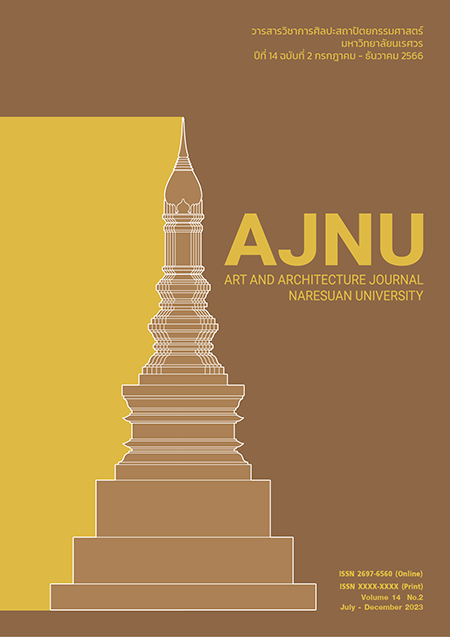Dyeing the cotton with natural colors from Karonda (Carissa Carandas Linn.) powder
Main Article Content
Abstract
This study objectives to 1. study dyeing of cotton with natural colors from Karonda (Carissa carandas Linn.) powder, 2. design products from cotton dyed with Karonda (Carissa carandas Linn.) powder, and 3. study the satisfaction of questionees towards a product prototype. The methodology consists of three phases. Phase 1 to study the dyeing by preparing dyeing water from 50 ml of water and three different weights of Karonda (Carissa carandas Linn.) powder which are 1, 3, and 5 g. Each concentration is tested using 30, 60, and 90 mins. Then, they are analyzed using Ducan’s multiple tests. Color values are measured using CLE LAB. Phase 2 to design products from cotton dyed with Karonda (Carissa carandas Linn.) powder using the tie-dye method and phase 3 to evaluate the satisfaction of questionees towards a product prototype. Research Instrument are interview form, product draft, and satisfaction questionnaires. Samples are 100 persons who evaluate the satisfaction towards product prototype who are selected using accidental sampling. Data is analyzed using frequency, percentage, mean, and standard deviation. Results indicated that dyeing using Karonda (Carissa carandas Linn.) powder at the concentration of 5 g per 50 ml of water for 90 mins provides the lowest lightness (L) of 53.51a 0.09 (highest color intensity), a* of 15.44b 0.99 representing red adhesion, and b* of 9.86c 0.02. For the design and satisfaction evaluation towards the bag prototype consisting of models A, B, and C, the overall satisfaction is high.
Article Details

This work is licensed under a Creative Commons Attribution-NonCommercial-NoDerivatives 4.0 International License.
References
เฉลิมพร ทองพูน. (2559). การพัฒนาสีย้อมธรรมชาติสำหรับฝ้ายและไหมจากเปลือกต้นกระท้อน. (รายงานวิจัย). พิษณุโลก:
มหาวิทยาลัยราชภัฏพิบูลสงคราม.
นวลแข ปาลิวนิช. (2542). ความรู้เรื่องผ้าและเส้นใย (ปรับปรุงใหม่). กรุงเทพฯ: ซี เอ็ดยูเคชั่น.
ผ่องศรี รอดโพธิ์ทอง (2560). พืชพื้นเมืองสำหรับย้อมผ้าสีดำ. วารสารวิชาการคณะสถาปัตยกรรมศาสตร์ สจล, 25(2), 163-175.
พิชิต โชดก และสุพิชญา คำคม. (2563). การหาสภาวะที่เหมาะสมของการสกัดสำหรับเพิ่มสารออกฤทธิ์ทางชีวภาพและฤทธิ์การต้าน
อนุมูลอิสระจากผลมะม่วงหาวมะนาวโห่ (Carissa carandas Linn.) โดยวิธีพื้นผิวตอบสนอง. วารสารวิทยาศาสตร์บูรพา,
(2), 617-635.
ภัทรานิฎชณ์ พิมพ์ประพร (2558). การศึกษาอิทธิพลของสารช่วยติดสีต่อเฉดสีของสีย้อมธรรมชาติที่สกัดจากใบหมี่บนเส้นใยไหม
ย้อมด้วยกระบวนการย้อมแบบดูดซึม. (ปริญญาวิศวกรรมศาสตรมหาบัณฑิต). ปทุมธานี: มหาวิทยาลัยเทคโนโลยีราชมงคล
ธัญบุรี.
วุฒิพงษ โรจนเขษมศรีและ ศักดิ์ชาย สิกขา. (2562). การพัฒนาผลิตภัณฑ์จากทุนวัฒนธรรมใหสอดคลองกับความต้องการของตลาด :
กรณีศึกษากิจการสายใจทอผามัดหมี่ ตําบลอุมจาน อําเภอประจักษศิลปาคม จังหวัดอุดรธานี. วารสารวิชาการ
ศิลปะสถาปตยกรรมศาสตร มหาวิทยาลัยนเรศวร, 12 (1), 98-109.
สำนักงานนโยบายและทรัพยากรธรรมชาติและสิ่งแวดล้อม. (2554). รายงานสถานการณ์คุณภาพสิ่งแวดล้อม พ.ศ.2554.
กรุงเทพฯ.
Huppatz, D.J. (2020). The key concepts : Design. New York: Trademarks of Bloomsbury Publishing.


